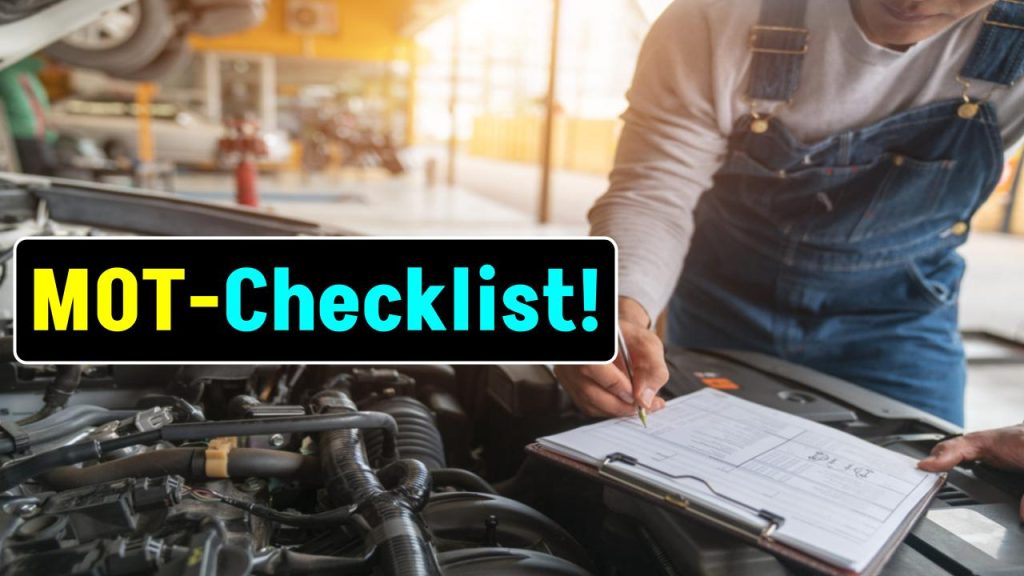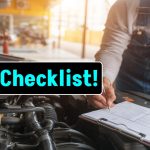
Getting your car ready for its MOT (Ministry of Transport) test can save you time, money, and hassle. A failed MOT means extra repairs, retesting, and potentially being unable to drive your car until it passes. The good news? Many common reasons for MOT failure are easy to fix at home.
In this guide, we’ll break down a step-by-step MOT checklist to help you pass the test the first time. Whether you’re a seasoned driver or a new car owner, this guide will give you all the information you need.
MOT Checklist
| Topic | Details |
|---|---|
| MOT Test | The MOT is a mandatory vehicle safety check required annually for most vehicles over three years old. |
| Common Failures | 1. Lighting and signaling issues (25% of failures) 2. Tyres below legal tread depth 3. Brake problems 4. Visibility issues (windscreens, wipers, mirrors) 5. Suspension problems |
| Cost of MOT | Prices vary, but the UK maximum fee for a car is £54.85. Many garages offer discounts. |
| Success Rate | Around 30-40% of vehicles fail their first MOT. A simple pre-check can increase pass rates. |
| Official Link | GOV.UK – MOT Test Info |
Passing your MOT doesn’t have to be stressful. By checking these simple things in advance, you can avoid common failures, save money on retests, and keep your car safe. Whether you’re an experienced driver or a first-time car owner, this easy MOT checklist ensures you’re prepared.
Also Check: Apply for Fully Funded Confucian Scholarship 2025 at Shandong University – Check Details!
MOT Checklist: What is an MOT Test and Why is it Important?
An MOT test is an annual safety check that ensures your car meets legal road safety and environmental standards. If your vehicle is more than three years old, you must take the test every year.
Why is it important?
- It’s illegal to drive without a valid MOT unless you’re driving to a test appointment.
- It keeps your car safe by checking for critical safety issues.
- It can save you money by identifying minor issues before they turn into costly repairs.
MOT Checklist: 10 Simple Steps to Pass First Time
Check Your Lights and Indicators
Faulty lights are the #1 reason for MOT failures!
What to do:
- Test all lights, including headlights, brake lights, indicators, reverse lights, and number plate lights.
- Replace any blown bulbs and clean dirty lenses.
- Ensure indicator lights flash correctly and aren’t too dim.
Inspect Your Tyres and Wheels
Did you know? Around 10% of MOT failures are due to tyre issues.
What to do:
- Tread Depth: The legal minimum is 1.6mm. Use a 20p coin to check—insert the coin into the tread; if the outer rim is visible, the tyre is worn and needs replacing.
- Tyre Condition: Look for cracks, bulges, or embedded objects (like nails).
- Tyre Pressure: Check your car manual for the correct pressure and inflate if needed.
Test Your Brakes
Faulty brakes are a serious safety risk—and an MOT failure!
What to do:
- Drive at a low speed and apply the brakes—do they stop smoothly?
- Listen for grinding or squealing noises—this could mean worn brake pads.
- Test the handbrake—does it hold the car securely on a slope?
Examine the Steering and Suspension: Bouncy suspension or unresponsive steering can lead to a fail.
What to do:
- Bounce test: Push down on each corner of the car. It should return to position smoothly.
- Check for knocking or clunking sounds when turning—this could mean worn suspension components.
- Steering wheel play: If it feels loose or doesn’t respond properly, get it checked.
Check the Windscreen and Wipers
A clear view of the road is essential!
What to do:
- Look for cracks or chips—damage larger than 10mm in the driver’s view or 40mm anywhere else will cause a fail.
- Replace worn wiper blades—they should clear water effectively, without streaks.
- Top up washer fluid—it’s a small thing, but an empty reservoir is an instant fail!
Inspect Seatbelts for Damage
A seatbelt that doesn’t work properly is an automatic fail.
What to do:
- Pull on each seatbelt—does it fasten securely and retract properly?
- Look for fraying, cuts, or damage.
- If a seatbelt is jammed or doesn’t lock properly, get it fixed.
Test the Exhaust System: A noisy or smoking exhaust means trouble!
What to do:
- Start the engine—listen for unusual loud noises.
- Look for excessive smoke (blue, black, or white) from the exhaust.
- Check for loose or rusted parts under the car.
Clean and Check Your Number Plates: A dirty or unreadable plate can fail your MOT.
What to do:
- Ensure plates are clean and clearly visible.
- Check for correct spacing and font—incorrect styles will fail the test.
Test Your Horn: A working horn is a must!
What to do:
- Press the horn—does it sound loud and clear?
- If it’s weak, stuck, or silent, it may need repairing.
Ensure All Doors and Mirrors Work: Functional doors and mirrors are essential for safety.
What to do:
- Check that all doors open and close properly from both inside and outside.
- Ensure side mirrors are secure and adjustable.
Also Check: Fully Funded CSC Scholarship 2025 at Shenyang Aerospace University – Check Eligibility Criteria!
MOT Checklist (FAQs)
What happens if my car fails its MOT?
If your car fails, you’ll get a ‘refusal of MOT certificate’ and need repairs before retesting. Some garages offer a free retest within 10 working days.
Can I drive without an MOT?
No—driving without a valid MOT can result in a £1,000 fine (except if driving to a pre-booked test).
How long does an MOT take?
Most tests take 45-60 minutes.
How much does an MOT cost?
The maximum fee for a car is £54.85 (UK law). Many garages offer lower prices.
What should I do if I lose my MOT certificate?
You can get a replacement online at GOV.UK.









